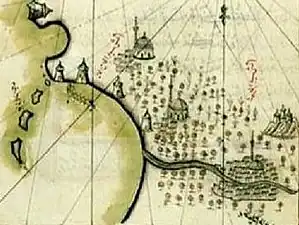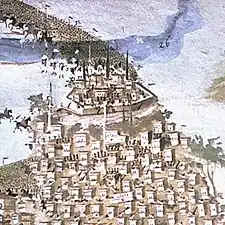Sultan Mehmed Mosque, Arta
The Sultan Mehmed Mosque (Greek: Σουλτάν Μεχμέτ Τζαμί, Turkish: Sultan Mehmet Camii), also known as the Suleyman Agha Mosque (Greek: Σουλεϊμάν Αγά Τζαμί, Turkish: Süleyman Ağa Camii), was an Ottoman mosque in the town of Arta, Greece, built within the Castle of Arta. It was one of the eight mosques of the town, and one of the six that no longer exist.
| Sultan Mehmed Mosque | |
|---|---|
 Old picture of the mosque by Edward Lear | |
 Location within Greece | |
| Alternative names | Suleyman Agha Mosque |
| General information | |
| Status | Destroyed |
| Type | Mosque |
| Architectural style | Ottoman architecture |
| Location | Arta |
| Country | Greece |
| Coordinates | 39°09′56.0″N 20°59′17.4″E |
| Completed | Around 15th century (?) |
| Destroyed | After 1881 |
| Technical details | |
| Material | Brick, stone |
History
During Ottoman times, the town of Arta had eight mosques, those being the Sultan Mehmed Mosque, the Feyzullah Mosque, the Sultan Bayazid Mosque, the Kiliç Bey Mosque, the Tekke Mosque, the Bey Mosque, the Faik Pasha Mosque and the Rokka Mosque. The first six were located within Arta proper, while the latter two were situated outside the town. Only Feyzullah and Faik Pasha survive to this day.[1][2][3]
According to the Metropolitan of Arta, Serafeim Xenopoulos, the construction of the mosque was ordered by Sultan Mehmed II, who, upon hearing about the erection of the Faik Pasha Mosque, wished for a new, larger mosque to be built and dedicated to him, but was not satisfied with the result and ordered the works for the mosque to be halted. The mosque as finalized by a servant of Faik Pasha, Suleyman Agha. To the mosque used to belong several lands from around the villages of Vigla and Strongyli, from whose exploitation the mosque would receive its income. Xenopoulos noted that the mosque had been built on top of an earlier Christian church, from which materials were taken, which can also be discerned by the existence of Christian symbols on the mosque's plates.[4][5]
Arta was annexed by the Kingdom of Greece on 24 June 1881 (O.S.). After that gradually began a deliberate reshaping of the urban plan of Arta aiming the removal of all those elements that reminded and bespoke of the town's recent Ottoman past. It is theorized that the Sultan Mehmed Mosque was one of the very first Ottoman monuments to be targeted and eventually destroyed due to its symbolic location inside the castle, while the vast majority of the rest of the reminders of the Ottoman period where left neglected to rot and collapse after the Muslim inhabitants of Arta fled.[6]
Pictorial evidence
One of the first known depictions of it was created by Ottoman writer Piri Reis in the fifteenth century, who drew Arta with the castle mosque, Faik Pasha Mosque and the mosque of Rokka. In 1686 Jacob Enderlin, a German engraver and publisher, created an engraving depicting Arta with Sultan Mehmed Mosque. In 1839, Panagiotis Zographos drew, under the guidance of Yannis Makriyannis, the siege of Arta in late 1821, during the Greek War of Independence. Zographos' painting shows the castle, the sprawl of the town, as well as the Sultan Mehmed, Sultan Beyazid and Kiliç Bey mosques. One of the most notable depictions was created by English writer and artist Edward Lear, who visited Arta in 1851. In his work, Lear depicted Arta with the Clock Tower, the mosques and the castle. A similar engraving was made by English engraver Edmund Evans, who visited the town in April of 1854.[7]
Architecture
Sultan Mehmed Mosque used to have two storeys, a brick-covered roof, and a minaret decorated with colourful stones. The exact date of its construction is not known, but it has been suggested it was built around the same time as Faik Pasha Mosque as. Its erection on the highest point of the castle made it visible from a larger distance. The location was not picked in chance, as the founding of Ottoman buildings in the most prominent positions was used as a sign of power against the Christian population of Arta. Inside the castle, near the mosque, once were houses, a barracks and prisons, while at the gate an imaret functioned which offered food to the poor for free.[8][9][10]
Gallery
- Sultan Mehmed Mosque
 Arta and its mosques by Piris Reis
Arta and its mosques by Piris Reis Imaginative rendering of Arta in an engraving by Jacob Enderlin
Imaginative rendering of Arta in an engraving by Jacob Enderlin Castle and mosques engraving by Panagiotis Zographou.
Castle and mosques engraving by Panagiotis Zographou. The castle by Edward Lear, 1849.
The castle by Edward Lear, 1849. The castle by Edmund Evans, 1854.
The castle by Edmund Evans, 1854.
References
- Serafeim Xenopoulos, Δοκίμιον Ιστορικόν περί Άρτης και Πρεβέζης (1884), pp. 176-179.
- «The population of Arta exceeds 6000: it contains six mosques, and twentyfour Greek churches.», Travels in Albania and Other Provinces of Turkey in 1809 & 1810, Volume 1, John Cam Hobhouse Broughton.
- «The population of Arta exceeds 6,000; it contains six mosques, and twenty-four Greek churches;», Travels in the Ionian Isles, Albania, Thessaly, Macedonia, &c: during the years 1812 and 1813, Sir Henry Holland, Volume 1., p.84 ,1815.
- Serafeim Xenopoulos, Δοκίμιον Ιστορικόν περί Άρτης και Πρεβέζης (1884), p. 179" «Το μεν Β. εις όνομα άδηλου άγιου σωζομένων εισέτι πολλών πλακών, έγκεχαραγμένους έχουσών σταυρούς».
- Fotis Vrakas, Περίπατος στην Οθωµανική Άρτα 1449 – 1881 και από την απελευθέρωση, p.23.
- Anastasios Orlandos, Αρχείο των Βυζαντινών Μνημείων της Ελλάδας (1935), p. 200
- Fotis Vrakas, Η Άρτα και ο Αμβρακικός κόλπος από τον 15ο ως τον 20ο αιώνα μέσα απο χαρακτικά και πίνακες
- Christopher Wordsworth Greece: Pictorial, Descriptive, and Historical (1839), p. 235: «Just within the north-eastern horn of this curve stands a castle of the Greek empire, distinguishable by the painted minaret of its mosque.»
- Serafeim Xenopoulos, Δοκίμιον Ιστορικόν περί Άρτης και Πρεβέζης (1884), p. 177: «Το έντος του φρουρίου τέμενος Σουλτάν Μεχμέτ, και τούτου ή χρονολογία σχεδόν άγνωστος, καθότι ένουδενί τών κτιρίων άναφαίνεται τι, εκ παραδόσεως όμως εικάζεται ότι σύγχρονόν έστι τών Μαρατίω τού Φαήκ Πασσά.».
- Evangelos Kontogiannis (2014) Ιμαρέτ-Φεϋζούλ: Επαρμηνεύοντας τα τεμένη της Άρτας p. 24
Bibliography
- Xenopoulos, Serafeim, Δοκίμιον ιστορικής τινος περιλήψεως τής ποτε αρχαίας και εγκρίτου Ηπειρωτικής πόλεως Άρτης και της ωσαύτως νεωτέρας πόλεως Πρεβέζης / Συλλεγέν και συνταχθέν υπό του μητροπολίτου Άρτης Σεραφείμ του Βυζαντίου, Athens, 1884.

